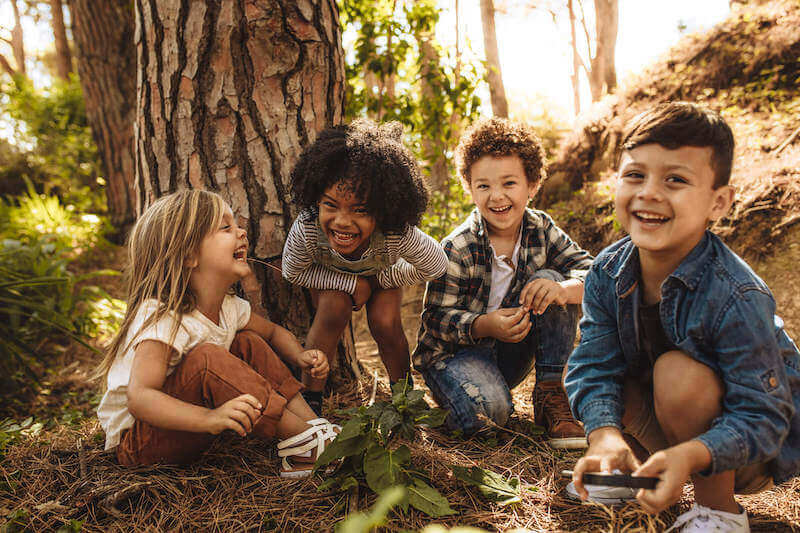While navigating the complexities of modern life filled with distractions and technology, integrating mindfulness practices becomes not only a means of managing stress but also a transformative tool for nurturing healthier, more connected, and emotionally intelligent individuals and families. Here we’ll dive into some mindfulness activities for children and for the whole family.
How to Introduce Mindfulness Activities for Kids
Mindful Surroundings
Establishing a calm environment is essential. Designate a quiet space for mindfulness activities, free from distractions, where both children and adults can engage in mindful practices without interruption.
You can set aside a corner of a room or a specific room where children know they can escape from the noise and distractions whenever they need a moment to disconnect and recharge. This space may also be particularly helpful for children who may struggle with sensory overload.
Mindful Breathing Exercises
Teach children simple breathing exercises to help them connect with their breath. For instance, practice “belly breathing,” where they focus on inhaling deeply through the nose, feeling their belly rise, and exhaling slowly through the mouth (Mindful.org).
You can talk your child through paying close attention to their shoulders rising, their lungs expanding, and holding their breath for a moment. Then the sensation when their muscles relax, their shoulders drop, and their stress dissipates.
Mindful Listening and Observation
Engage children in activities that promote mindful observation, such as nature walks or listening to calming music. Encourage them to notice details they might otherwise overlook, creating a deeper connection to their surroundings.
Have them pick a favorite calming song. They can focus on song lyrics that speak to them, instruments they can recognize, or just their overall feelings as they close their eyes and tune out distractions.
Mindful Eating
Turn mealtime into a mindful experience. Start by eliminating other distractions, such as eating away from the television or removing cell phones from the dinner table.
Encourage kids to savor each bite, paying attention to flavors, textures, and smells. This not only enhances their connection to food but also promotes gratitude, appreciation, and mindfulness of when their body is full (National Institute of Health, 2021).
Mindfulness Activities for the Whole Family
Family Mindfulness Routines
Building mindfulness in families is about creating a mindful atmosphere through shared rituals. Families can bring mindfulness into their daily lives by setting up routines that encourage everyone to focus on the present moment together.
Adding a quick mindfulness session to the morning routine, like a short family meditation or a moment of gratitude during breakfast, can start the day on a positive and purposeful note. In the evening, families can do a short guided relaxation or breathing exercise together before bedtime to create a calm atmosphere for a good night’s sleep.
Establishing routines helps families create a sense of togetherness and allows them to begin and end their day with a shared focus on being present and optimistic (Ruotolo & Mattox, 2023).
Digital Detox
Constant connection to the digital world introduces external stressors, impacts mental health, and can impede a good night’s sleep (Cherry, MsED, 2023). Taking a break from screens as a family is a great way to practice mindfulness by purposefully stepping away from digital distractions.
Instead of being glued to individual screens, families can do activities that encourage mindfulness, like going on outdoor adventures, playing board games, or completing a craft without the interruption of devices.
Most important for a family digital detox is being realistic about it. Choose a timeframe where no one has work obligations or homework deadlines. You can do mini-detoxes in the evenings, or even just establish device-free meal times throughout the week. This intentional pause from digital distractions creates room for real connections and quality time.
Open Communication
Keeping communication open in a family is key for successful mindfulness together. Creating an environment where everyone feels confident expressing their thoughts and feelings builds a base for understanding and support.
Open communication “means showing up with our partners and kids with an open heart and an open mind. It builds on listening with curiosity and creates space for everyone to feel comfortable to share how they feel and what they need” (Mindful.org). Having regular family meetings can facilitate open communication, giving each member a chance to talk about their experiences, problems, and achievements.
Encourage family members to practice daily mindfulness by listening during discussions and really paying attention without getting distracted. This not only helps everyone understand each other better but also builds a culture of trust within the family.
Introducing mindfulness to children and families can significantly benefit their overall well-being. You can learn more in our article about the Impact of Mindfulness here.
In a world teeming with distractions, instilling mindfulness in children provides them with essential skills that contribute to a healthy and joyful life. By incorporating straightforward yet impactful mindfulness activities into daily routines, families establish a foundation for emotional resilience, improved focus, and strengthened connections.
Works Cited
- Mindful.org, “Mindfulness for Kids,” https://www.mindful.org/mindfulness-for-kids/
- National Institute of Health, “Mindfulness for Your Health: The Benefits of Living Moment by Moment,” News in Health, June 2021, https://newsinhealth.nih.gov/2021/06/mindfulness-your-health
- Ruotolo, Kara-Lee and Mattox, Tai, “How to Make Mindfulness Part of Your Family Routine,” Mindful.org, November 29, 2023, https://www.mindful.org/how-to-make-mindfulness-part-of-your-family-routine/




